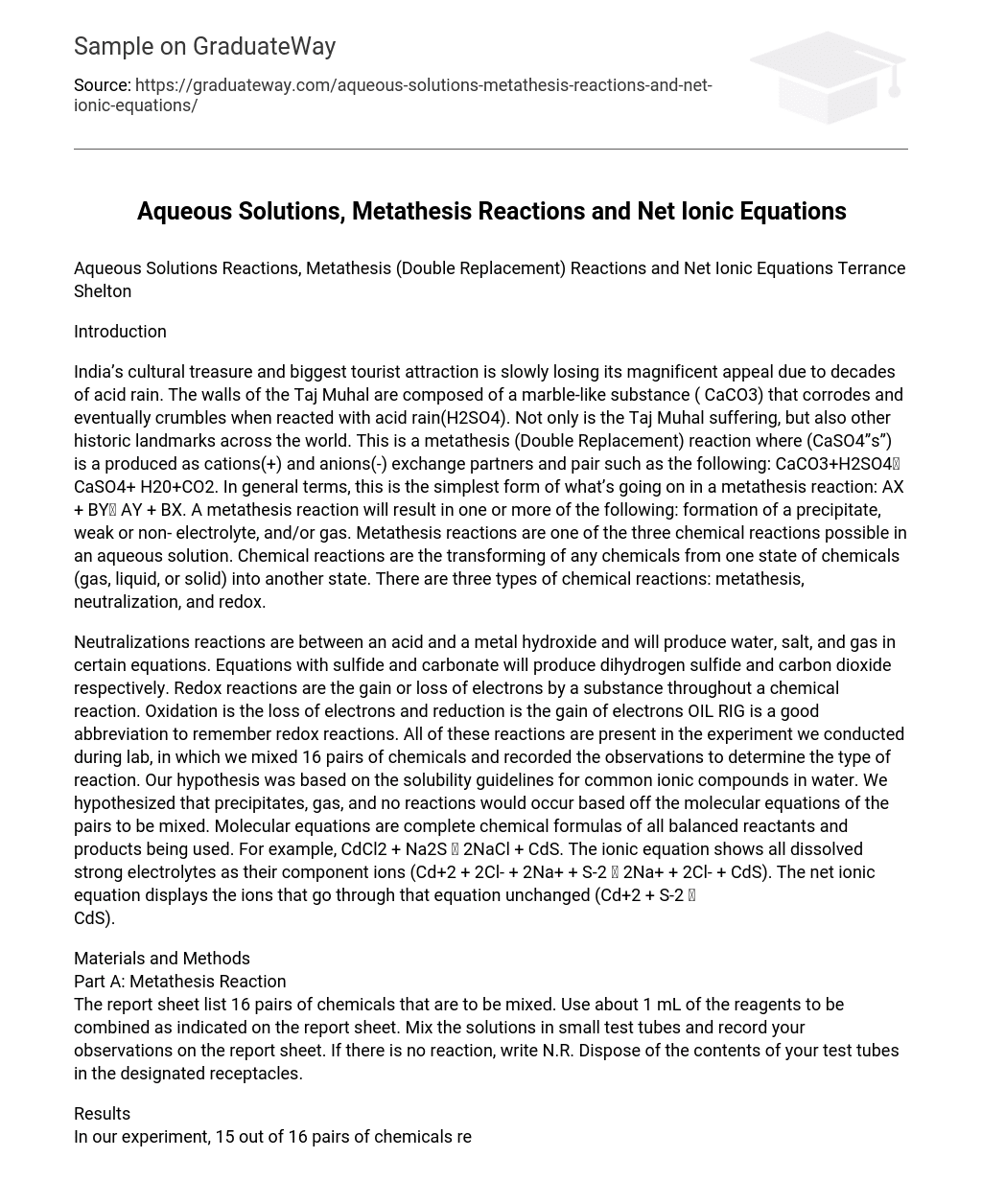Aqueous Solutions Reactions, Metathesis (Double Replacement) Reactions and Net Ionic Equations Terrance Shelton
Introduction
India’s cultural treasure and biggest tourist attraction is slowly losing its magnificent appeal due to decades of acid rain. The walls of the Taj Muhal are composed of a marble-like substance ( CaCO3) that corrodes and eventually crumbles when reacted with acid rain(H2SO4). Not only is the Taj Muhal suffering, but also other historic landmarks across the world. This is a metathesis (Double Replacement) reaction where (CaSO4”s”) is a produced as cations(+) and anions(-) exchange partners and pair such as the following: CaCO3+H2SO4à CaSO4+ H20+CO2. In general terms, this is the simplest form of what’s going on in a metathesis reaction: AX + BYà AY + BX. A metathesis reaction will result in one or more of the following: formation of a precipitate, weak or non- electrolyte, and/or gas. Metathesis reactions are one of the three chemical reactions possible in an aqueous solution. Chemical reactions are the transforming of any chemicals from one state of chemicals (gas, liquid, or solid) into another state. There are three types of chemical reactions: metathesis, neutralization, and redox.
Neutralizations reactions are between an acid and a metal hydroxide and will produce water, salt, and gas in certain equations. Equations with sulfide and carbonate will produce dihydrogen sulfide and carbon dioxide respectively. Redox reactions are the gain or loss of electrons by a substance throughout a chemical reaction. Oxidation is the loss of electrons and reduction is the gain of electrons OIL RIG is a good abbreviation to remember redox reactions. All of these reactions are present in the experiment we conducted during lab, in which we mixed 16 pairs of chemicals and recorded the observations to determine the type of reaction. Our hypothesis was based on the solubility guidelines for common ionic compounds in water. We hypothesized that precipitates, gas, and no reactions would occur based off the molecular equations of the pairs to be mixed. Molecular equations are complete chemical formulas of all balanced reactants and products being used. For example, CdCl2 + Na2S à 2NaCl + CdS. The ionic equation shows all dissolved strong electrolytes as their component ions (Cd+2 + 2Cl- + 2Na+ + S-2 à 2Na+ + 2Cl- + CdS). The net ionic equation displays the ions that go through that equation unchanged (Cd+2 + S-2 à
CdS).
Materials and Methods
Part A: Metathesis Reaction
The report sheet list 16 pairs of chemicals that are to be mixed. Use about 1 mL of the reagents to be combined as indicated on the report sheet. Mix the solutions in small test tubes and record your observations on the report sheet. If there is no reaction, write N.R. Dispose of the contents of your test tubes in the designated receptacles.
Results
In our experiment, 15 out of 16 pairs of chemicals reacted successfully. 9 of those reactions produced a precipitate and 4 out of 15 a gas. The remaining 2 of the successful 15 reactions produced water only. Reaction
Observations
Copper (II) Sulfate + Sodium Carbonate
Light blue precipitate formed (CuCo3)
Copper (II) Sulfate + Barium Chloride
Off white precipitate formed (BaSO4)
Copper (II) Sulfate + Sodium Phosphate
Tiny white precipitates formed (Cu3(PO4)2)
Cadmium (II) Chloride + Sodium Sulfide
Changed from yellow to orange; Precipitate formed (CdS)
Cadmium (II) Chloride + Sodium Hydroxide
Off white precipitate formed (Cd(OH)2)
Nickel (II) Chloride + Silver Nitrate
Changed to a white precipitate fast (2AgCl)
Nickel (II) Chloride + Sodium Carbonate
Changed to a white precipitate (NiCO3)
Lead (II) Nitrate + Sodium Sulfide
Black precipitate formed (PbS)
Lead (II) Nitrate + Sulfuric Acid
White precipitate formed (PbSO4)
Potassium Chloride + Sodium Nitrate
No Reaction
Sodium Carbonate + Sulfuric Acid
Bubbled A bit (C02)
Sodium Carbonate + Hydrochloric Acid
Bubbled A bit (C02)
Ammonium Chloride + Sodium Hydroxide
pH changed; Blue Color ( NH3)
Sodium Sulfide + Hydrochloric Acid
pH=0; (H2S)
Conclusion
The observations from the table in results implies that like ionic molecules such as an acid plus acid or base plus base reaction will not yield a chemical reaction. This means that only unlike ionic molecules such as a strong base and acid will always react to produce water, a gas, a salt or a precipitate. I accept our hypothesis because only one reaction was unsuccessful due to their basic properties and chemical formulas. All other acids and bases reacted as hypothesized. We worked in a controlled environment controlling specific variables in our experiment such as lighting for chemical visibility, molarity of chemical pairs, and the amount of each pair used to react with one another.





